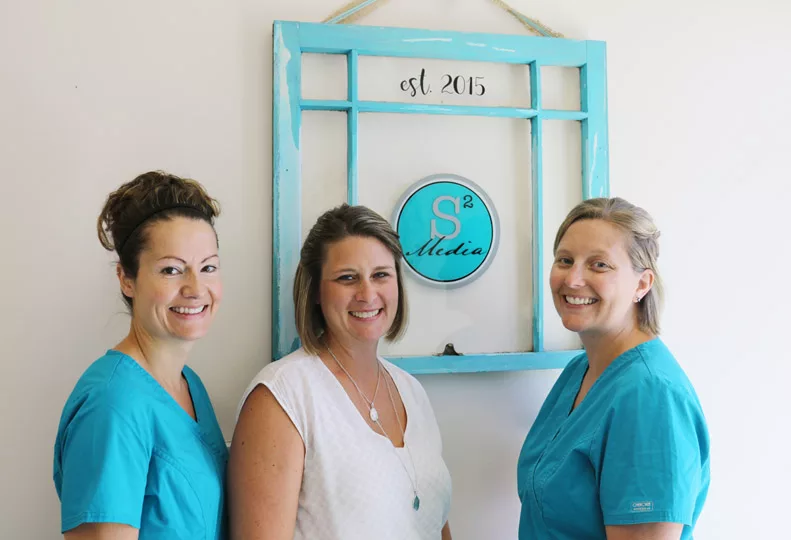S2 Media: Bringing business under the microscope
-

Spokane Valley-based S2 Media, a women-owned and -operated company that manufactures microbiological dishes, is eager to begin offering more products and expanding into the market, its co-owners say.
S2 Media is a division of S2M Enterprises LLC, which was founded in November 2015 by Stephanie Bernards, a microbiologist and the company’s executive director; Sommer Teague, a chemist and its operations director; and Molly Paridon, who has a background in business management and is supply chain and marketing director.
All three met as employees of Jubilant HollisterStier, a pharmaceutical contract manufacturing company with a large operation here.
The main product that S2 produces is a kind of petri dish, containing a gel-like, solid nutrient that will support the growth of microorganisms, enabling them to be studied or tested in a lab. Within the industry, these plates are referred to as culture media, because they host the living material or “culture” of either bacteria or viruses for study.
Bernard says that once the three women realized there was a market in the Pacific Northwest for creating high quality microbiological culture media, they decided to start their own company.
“Basically we supply, manufacture, and produce a product that is used in multiple industries for the purpose of microbiological testing,” she says.
Teague explains it a bit differently, saying, “S2 provides a plate that contains food for these organisms. If for example, a patient goes to the doctor to be tested for a bacterial infection like strep throat, the doctor would take a swab. That swab sample is then taken to a lab, where it would be added to one of these plates and allowed to grow until it can be identified.”
“It’s basically what we might call bug food,” says Paridon.
S2 is located in a 5,000-square-foot office and warehouse space within the Woodruff Business Park, at 2205 N. Woodruff Road. The company’s warehouse space takes up 4,000 square feet and includes a fully functional microbiology lab, and a 144-square-foot clean room environment.
Bernards says, “The clean room has an interior filter to remove dust and particulates from the air. This provides a sterile environment in which to fill the plates, and package them for distribution.” Anyone entering the clean room must wear a cap, gown, and gloves to reduce contamination.
Paridon says the company has a monthly capacity of 30,000 plates, although its largest batch size is somewhere around 1,500 plates.
“Most industries have a minimum order they need to fill, but we’re open to smaller orders as well, and have gone as small as a 10-plate batch,” she says.
According to Paridon, certain industries may need their plates to all come from the same batch, and many have to test and confirm that the media hasn’t been damaged during transit.
“We document everything, and each product we release comes with a certificate of analysis,” she says. “All of our equipment is also qualified.”
Culture media plates like those created by S2, can hold either solid or liquid nutrients, depending on the type of sample needed.
So far S2 manufactures 13 different media products, all of them being solid culture types that use the nutrient agar, a gelatinous substance derived from seaweed.
“There are 2,700 different types of plates that can be used for lab testing,” says Bernards. “When we started we chose 13 that could apply to various industries. As we grow we’d like to keep evaluating and adding to that list of products so we can stay competitive.”
Bernards says the plates created at S2 can be used for testing in multiple industries, including academic research, environmental, public and state health, pharmaceutical, nutraceutical, and veterinary labs. Plates also can be used in breweries, wineries, distilleries, cannabis testing labs, and in the manufacturing of food or cosmetics.
Soon, the company hopes to be able to offer products that use the liquid medium, also called broth, as the main nutrient.
“If we were able to add liquid products, that would give our company twice the market,” Bernards says. “Those types of samples are useful in the testing of both waste water and drinking water, as well as certain medical testing.”
Currently the company is working on acquiring a device called a tube filler, which is able to rapidly fill multiple testing vials at once, and would make the process of offering liquid products easier to accommodate.
While new technology that automates certain microbiological tests is on the horizon, Bernards maintains there will still be a need for culture media products.
“Some processes still can’t be automated,” she says. “Industries like health care will still require lots of equipment and media for microbiological testing, and the FDA is also coming out with new regulations this year that will play a huge part in tests needed for food manufacturing.”
While S2 is able to ship product almost anywhere, Bernards says its main service area includes Washington, Idaho, Montana, and Oregon.
So far the company has 10 clients, located mostly in the Inland Northwest, although it hopes to increase that number soon.
“We spent most of this past year getting all the equipment set up and qualified, and pursuing validations,” says Teague. “You have to have certain qualifications before you can start acquiring clients, and be considered a vendor. It takes a lot of calls and site visits.”
She says S2 adheres to cGMP, Current Good Manufacturing Practice regulations, and its products comply with the Clinical and Laboratory Standards Institute’s requirements, as well as United States Pharmacopeial Convention standards for commercially prepared microbiological culture media.
The three co-owners are the company’s only employees, with the exception of three sales representatives, one each in Washington, Oregon, and Idaho.
Looking ahead, Bernards says the company’s goal is to be a dependable source of culture media for the Pacific Northwest, producing quality products and shipping them in a timely manner.
“In the past we’d seen this type of media have issues in shipping, often arriving contaminated, dehydrated, or damaged, and you see companies paying more for better shipping, or for replacement product,” she says. “We wanted to alleviate those issues.”
While the company is not yet making a profit, Teague says it expects to be seeing returns on its investment within the next year.
“Starting this business involved a pretty substantial startup,” she says. “We built this all from the ground up, qualifying our equipment, setting it up, writing procedures, and traveling with our sales force to meet clients. It’s pretty rewarding to see what we’ve accomplished, especially in what is still considered a male-dominated field.”
Related Articles
Related Products

_c.webp?t=1763626051)

